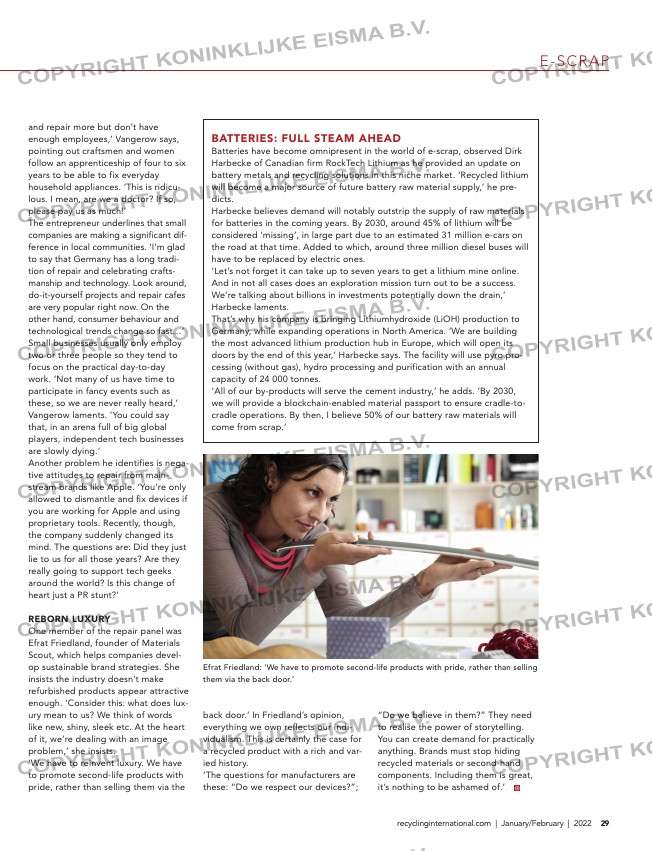Page 29 from: Recycling International February issue | 2022

E-SCRAP
29recyclinginternational.com | January/February | 2022
and repair more but don’t have
enough employees,’ Vangerow says,
pointing out craftsmen and women
follow an apprenticeship of four to six
years to be able to fix everyday
household appliances. ‘This is ridicu-
lous. I mean, are we a doctor? If so,
please pay us as much!’
The entrepreneur underlines that small
companies are making a significant dif-
ference in local communities. ‘I’m glad
to say that Germany has a long tradi-
tion of repair and celebrating crafts-
manship and technology. Look around,
do-it-yourself projects and repair cafes
are very popular right now. On the
other hand, consumer behaviour and
technological trends change so fast…’
Small businesses usually only employ
two or three people so they tend to
focus on the practical day-to-day
work. ‘Not many of us have time to
participate in fancy events such as
these, so we are never really heard,’
Vangerow laments. ‘You could say
that, in an arena full of big global
players, independent tech businesses
are slowly dying.’
Another problem he identifies is nega-
tive attitudes to repair from main-
stream brands like Apple. ‘You’re only
allowed to dismantle and fix devices if
you are working for Apple and using
proprietary tools. Recently, though,
the company suddenly changed its
mind. The questions are: Did they just
lie to us for all those years? Are they
really going to support tech geeks
around the world? Is this change of
heart just a PR stunt?’
REBORN LUXURY
One member of the repair panel was
Efrat Friedland, founder of Materials
Scout, which helps companies devel-
op sustainable brand strategies. She
insists the industry doesn’t make
refurbished products appear attractive
enough. ‘Consider this: what does lux-
ury mean to us? We think of words
like new, shiny, sleek etc. At the heart
of it, we’re dealing with an image
problem,’ she insists.
‘We have to reinvent luxury. We have
to promote second-life products with
pride, rather than selling them via the
back door.’ In Friedland’s opinion,
everything we own reflects our indi-
vidualism. This is certainly the case for
a recycled product with a rich and var-
ied history.
‘The questions for manufacturers are
these: “Do we respect our devices?”;
“Do we believe in them?” They need
to realise the power of storytelling.
You can create demand for practically
anything. Brands must stop hiding
recycled materials or second-hand
components. Including them is great,
it’s nothing to be ashamed of.’
BATTERIES: FULL STEAM AHEAD
Batteries have become omnipresent in the world of e-scrap, observed Dirk
Harbecke of Canadian firm RockTech Lithium as he provided an update on
battery metals and recycling solutions in this niche market. ‘Recycled lithium
will become a major source of future battery raw material supply,’ he pre-
dicts.
Harbecke believes demand will notably outstrip the supply of raw materials
for batteries in the coming years. By 2030, around 45% of lithium will be
considered ‘missing’, in large part due to an estimated 31 million e-cars on
the road at that time. Added to which, around three million diesel buses will
have to be replaced by electric ones.
‘Let’s not forget it can take up to seven years to get a lithium mine online.
And in not all cases does an exploration mission turn out to be a success.
We’re talking about billions in investments potentially down the drain,’
Harbecke laments.
That’s why his company is bringing Lithiumhydroxide (LiOH) production to
Germany, while expanding operations in North America. ‘We are building
the most advanced lithium production hub in Europe, which will open its
doors by the end of this year,’ Harbecke says. The facility will use pyro pro-
cessing (without gas), hydro processing and purification with an annual
capacity of 24 000 tonnes.
‘All of our by-products will serve the cement industry,’ he adds. ‘By 2030,
we will provide a blockchain-enabled material passport to ensure cradle-to-
cradle operations. By then, I believe 50% of our battery raw materials will
come from scrap.’
Efrat Friedland: ‘We have to promote second-life products with pride, rather than selling
them via the back door.’
Jelle Slenters: ‘Greenstocking’ parts and components can help match electronics demand
and supply in a sustainable way.
nowadays, owing to big sales. Having
your washing machine fixed, for exam-
ple, can cost up to EUR 170. A recent
consumer survey stated that 65% of
people don’t want to invest that much
money; they prefer to buy a new one.’
Using this logic, Vangerow argues that
one in every three vacuum cleaners is
thrown out. But many faults can easily
be resolved by replacing components
in a shop or by the consumer sending
it back to the producer. ‘The reality is,
this doesn’t happen on a large scale.
People consider it too much hassle,
and the industry doesn’t want to
encourage repair as it doesn’t earn
them any extra money.’
Meanwhile, the lockdown lifestyle dur-
ing the coronavirus pandemic saw
sales of fancy coffee machines and
autonomous cleaning mobile robots
reach new highs. The global vacuum
cleaner industry exceeded EUR 10 bil-
lion in 2020 and is expected to reach
EUR 19 billion by the end of 2027.
Sales for coffee machines topped EUR
6 billion and are heading towards EUR
8.5 billion by 2027.
E-WASTE DOCTORS
‘From what I know, 70% of repair busi-
ness want to grow their operations
26-27-28-29_ewastefrankfurt.indd 29 01-02-2022 10:26



